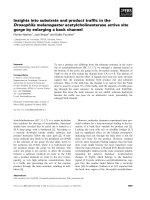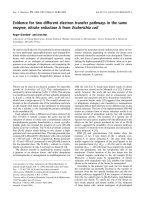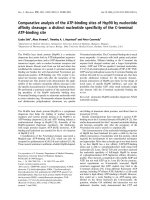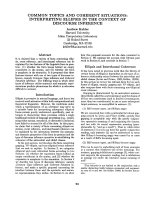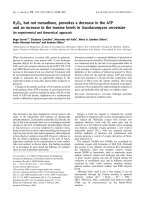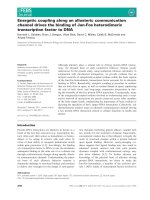báo cáo khoa học: " Does harm reduction programming make a difference in the lives of highly marginalized, at-risk drug users?" pot
Bạn đang xem bản rút gọn của tài liệu. Xem và tải ngay bản đầy đủ của tài liệu tại đây (235.67 KB, 7 trang )
BioMed Central
Page 1 of 7
(page number not for citation purposes)
Harm Reduction Journal
Open Access
Research
Does harm reduction programming make a difference in the lives of
highly marginalized, at-risk drug users?
Susan J Rogers*
1
and Terry Ruefli
2
Address:
1
Academy for Educational Development (AED), 100 Fifth Ave., New York, New York 10011, USA and
2
903 Dawson St., Bronx, New York
10459, USA
Email: Susan J Rogers* - ; Terry Ruefli -
* Corresponding author
Abstract
Harm reduction is a controversial model for treating drug users, with little formal research
available on its operation and effectiveness. In order to advance the field, we first conducted
participatory research of harm reduction with 120 clients using nominal-group technique to
develop culturally relevant outcomes to measure progress. Second, we conducted focus group
interviews with a different group of clients to help validate the outcomes. Third, we used the
outcomes in an evaluation of the largest harm reduction program in New York City, which involved
a representative sample of 261 and entailed baseline, post, and six follow-up assessments. The
participatory research resulted in outcomes of 10 life areas important to drug users. Evaluation
results showed that program participants made positive improvements across most outcomes,
with the most substantial progress made in how clients dealt with drug-use problems. Along with
their participation in the program, progress in some outcomes was also associated with clients'
type of drug use (i.e., stable vs. chaotic), where more stable drug use was associated with better
ways of making an income and types of housing. Surprisingly, progress was not associated with the
kinds or numbers of services received or the length of time in the program. This was attributed to
the service delivery model of harm reduction, in which clients are less inclined to associate their
success with a single staff person or with a single service or intervention received than with the
program as a whole.
Introduction
Harm reduction programs operate with the assumption
that some people who engage in high-risk behaviors are
unwilling or unable to abstain. Using a "low-threshold
approach," they do not require that clients abstain from
drug use to gain access to services, nor expect adherence to
one service to be eligible for another. Rather than having
abstinence goals set for them, clients in such programs
take part in a goal-setting process, an approach that has
been shown to correlate consistently with retention and
success [1,10]. Providers help clients make connections
among their complex attitudes, behaviors, and the change
they are trying to pursue through an interactive process,
not a dogmatic format. Behavior change is regarded as
incremental and based on the premise that people are
more likely to initiate and maintain behavior changes if
they have the power both to shape behavioral goals and
enact them.
Research on harm reduction programs has been limited
largely to demonstrating their success with reducing the
transmission of HIV/AIDS among drug users as a result of
Published: 01 June 2004
Harm Reduction Journal 2004, 1:7
Received: 22 February 2004
Accepted: 01 June 2004
This article is available from: />© 2004 Rogers and Ruefli; licensee BioMed Central Ltd. This is an Open Access article: verbatim copying and redistribution of this article are permitted in
all media for any purpose, provided this notice is preserved along with the article's original URL.
Harm Reduction Journal 2004, 1 />Page 2 of 7
(page number not for citation purposes)
access to sterile syringes [2-6,11-13]. While this is an
important accomplishment, little is known about the
other low-threshold services that these programs provide
and their overall impact in assisting drug users in making
changes in life conditions, circumstances, and quality of
life. This is partially due to a policy and funding environ-
ment that directs most support to traditional drug treat-
ment and leaves harm reduction initiatives at a
disadvantage. As a result, considerable research has been
conducted to develop outcomes of drug treatment and
assess its impact, while almost no research has tried to
establish appropriate measures of harm reduction and
evaluate its worth.
To advance the field of harm reduction, the investigators
designed a two-phase participatory research project. First
they conducted qualitative research with drug users in a
large urban harm-reduction program to develop culturally
appropriate outcome measures [8]. Second, they used
these measures to evaluate the effectiveness of the
program.
Program Description
The evaluation assessed the largest harm reduction pro-
gram in New York City, which was founded in 1990 by
former injection-drug users (IDUs) and activists as an
underground syringe-exchange program. It has served
over 51,000 marginalized drug users, predominantly in
the South Bronx and East Harlem, who are HIV sero-pos-
itive or at risk of infection. Those served included individ-
uals who were injection-drug users, crack smokers,
problem drinkers, and sex trade workers, as well as indi-
viduals who were living at 100% or more of poverty level;
who were foreign born, homeless, or in unstable living
arrangements; and who lacked a regular source of medical
care.
The major operating principles of the program include the
following: (1) always be mobile and deliver services to
users on the streets and in settings where they live and use
drugs; (2) always provide services based on meeting users
where they are; and (3) always remain participant-driven
and centered on what users want and need. The major
goal of the program is to connect marginalized drug users
to needed services that will stabilize their lives and
improve their well-being.
The services offered in the program include the following:
• Intensive street outreach to locate, engage, and retain
IDUs and their significant others who are HIV infected
and/or are at high risk of infection because of injection
drug use/and or risky sexual behavior;
• Street-side services through two mobile vans, including
a hospital medical unit conducting HIV primary care, HIV
testing, STD screening, ob-gyn examinations, minor sur-
gery, health screenings, and influenza vaccines;
• Health education, including safer injection education
and orientation to HIV and drug treatment services;
• Harm-reduction counseling, including recovery readi-
ness, relapse reduction, and long-term recovery;
• Assertiveness training for negotiating safer sex, reducing
exploitation during commercial sex transactions, and
reducing the harm of abusive relationships;
• One-for-one exchange of sterile syringes for used
syringes;
• Support groups, including a users', men's, women's, and
gay and lesbian groups;
• Acupuncture (ear and full-body) and Reiki;
• Transitional case management, including facilitation of
access to HIV counseling and testing, primary care, inten-
sive case management, drug treatment, housing, and men-
tal health and nutritional services;
• Access to early intervention to locate, identify, engage,
and then connect marginalized people who are HIV+ or at
high risk of HIV to the AIDS service delivery system and to
a range of HIV-related services (e.g., HIV testing, primary
medical care, case management, drug treatment, legal
services, and housing);
• Assistance in accessing entitlement benefits (Medicaid;
SSI; welfare; birth certificates) and access to an attorney;
and
• A 1–800 HOTLINE called GETTING CONNECTED to
access hard-to-reach clients.
Methods
The methods used for the participatory research are
described below, based on the two-phase approach of
outcome development and program evaluation.
Phase I outcome development
Qualitative research was conducted with clients in the
program to initially develop outcomes of harm reduction.
The study was advertised in the six program sites, and a
convenience sample of approximately 200 clients strati-
fied by neighborhood, duration in the program, and types
of services received was recruited. The demographics of
the sample closely represented the larger program and
Harm Reduction Journal 2004, 1 />Page 3 of 7
(page number not for citation purposes)
included 26% African American, 50% Latino, and 24%
white; 72% male and 28% female; 17% ≤29 years of age;
26% between 30–39 years; and 45% ≥40 years of age.
First, clients participated in groups that allowed them to
identify areas of life functioning that people like them-
selves (i.e., drug users) deemed important and meaning-
ful to work on in the harm reduction program – income,
housing, food (nutrition), family relations, self-improve-
ment; connectedness to services/benefits/programs, deal-
ing with negative feelings (mental health), health
problems (physical health), and legal and drug-use prob-
lems. With these 10 life areas, 10 groups of approximately
10 clients were conducted using nominal-group tech-
nique (NGT).[1] This resulted in 10 scaled outcomes,
which included measures of better to worse ways of mak-
ing an income, being housed, etc. [8]
Next, 10 focus groups were conducted with clients to
allow more of the target population to reflect on the valid-
ity of the measures. In most cases, a completely different
group of clients who had participated in the NGT process
for a certain outcome participated in the focus group
related to that same outcome. This qualitative research
resulted in hierarchical outcomes of harm reduction pro-
gramming to measure incremental change in pertinent life
areas from better to worse (Table 1 – see Additional File
1). These measures were considered culturally appropriate
to the way drug users see the world and live their lives. It
was also believed that these measures could show how cli-
ents improve over time.
Phase II evaluation
The main intent of the evaluation study was to assess
whether drug users in harm reduction make significant
progress in various life areas based on measures that were
culturally appropriate and meaningful to them. Using the
drug-user-generated outcomes from Phase I, instruments
were developed to collect data at several points in time to
measure client progress using a pre-, post-, and follow-up
design. The first assessment with clients in the study,
administered as face-to-face interviews, measured how cli-
ents' placed themselves on the scaled outcomes at base-
line, when they entered the program (a retrospective
measure), and "now" (i.e., post). Clients completing this
assessment were then asked to call an 1–800 telephone
number, one they used to regularly connect with the pro-
gram, every three weeks, over a year, to take part in phone
interviews with a trained interviewer who used an adapted
version of the developed instrument to assess their
progress with the outcomes.
Recruitment methods for Phase II were similar to those
used in Phase I, which had resulted in a convenience sam-
ple of 261 program clients stratified by neighborhood,
duration in the program, and types of services received. As
might be expected with the unstable nature of the target
population, study dropout took place across the follow-
up assessments, which reduced the size of the matched
sample that could be used for the evaluation. As the sam-
ple decreased over the follow-up assessments, the deci-
sion was made to use data from six of the seventeen
follow-up assessments, resulting in a sample of 96 pro-
gram participants for the evaluation with matched results
across baseline, post, and follow-up assessments. While
the follow-up sample was slightly older, more female and
more of Black/African American descent than the base-
line/post-sample, overall the demographics of the assess-
ment samples represented the larger client base in the
harm reduction program (Table 1).
Table 2: Demographic Characteristics of Clients in the Program and in the Baseline/Post and Follow-up Assessments
Characteristic Baseline/Post (N = 261) Follow-up (N = 96) Program Client Base (N =
51,282)
Age
≤29 years 11% 6% 13%
30–39 years 33% 27% 32%
≥40 years 56% 67% 55%
Sex
Male 62% 58% 67%
Female 37% 40% 29%
Transgender 1% 1% 1%
Unknown 3%
Race/Ethnicity
Latino 49% 41% 52%
Black or African American 33% 39% 28%
White 14% 17% 14%
Other 4% 3% 5%
Harm Reduction Journal 2004, 1 />Page 4 of 7
(page number not for citation purposes)
To explore the extent of client progress in the harm reduc-
tion program, data were analyzed using paired t-tests
between baseline, post, and follow-up scores. To explore
the influence of other factors on client progress, multiple
regression was performed.
Evaluation results
The evaluation explored two related questions. First, it
determined whether clients in harm-reduction program-
ming made overall progress from the time they entered
the program to their last follow-up assessment (i.e., from
baseline to their sixth follow-up assessment). Second,
because there tended to be more time between when par-
ticipants entered the program to the post-assessment (i.e.,
approximately 60% had been in the program a year or
longer) than from the post-assessment to the last follow-
up assessment (approximately 6 months), the evaluation
explored whether more client progress was made from
baseline to post-assessment than from post to the last fol-
low-up assessment.
Results based on these inquiries are shown in Table 2.
Findings show that there was significant client progress
across most outcomes from entrance in the harm reduc-
tion program to the last follow-up assessment (i.e., base-
line to follow-up), which is demonstrated in mean scores
on outcomes decreasing across the measurement points.
The exception to this finding was with the outcome of
"connectedness to valued programs/benefits." While
there was significant progress from baseline to post-
assessment, there was not significant progress from base-
line to follow-up.
Findings also show that there was not always significantly
more progress from entrance in the program to the post-
assessment than from post-assessment to follow-up
assessment across all outcomes. This expected result was
shown for the outcomes of housing, income, connected-
ness to programs/benefits, and dealing with drug prob-
lems. For the outcomes of family relations and handling
negative feelings, findings show that there was not signif-
icant change from baseline to post but there was from
post to follow-up. For the outcomes food (nutrition) and
dealing with legal problems, there was not significant
change from baseline to post or from post to follow-up,
although there was from baseline to follow-up. Finally,
for the outcome of health care, there was significant
change both from baseline to post and from post to
follow-up.
To further explore the positive relationship between client
progress in various life areas and participation in the harm
reduction program, a number of relevant factors were
explored to determine their impact on this relationship.
Using multiple regression, the factors of "amount of time
in the program," "program dosage received" (i.e., scope
and frequency of the multiple services offered), "type of
service received" and "type of drug use" (i.e., stable vs.
chaotic) were entered into the model for analysis. Surpris-
ingly, none of these factors had any consistent significant
relationship with progress made in program outcomes.
Stable drug use was marginally related to progress in the
outcome of housing (p ≤ .07) and significantly related to
progress in the outcome of income (p ≤ .05).
Discussion
While the findings from the evaluation were positive over-
all in showing a relationship in drug users' participation
in harm reduction programming and improvement in var-
ious life areas, there were a number of limitations of the
Table 3: Change Across Mean Scores of Outcomes from Baseline to Post to Follow-up
Life Areas Means Scores* Level of Significance
Baseline Post Follow-up Baseline vs.
Follow-up
Baseline vs.
Post
Post vs.
Follow-up
Housing 4.10 3.28 3.17 ≤.001 ≤.001 NS
Income 5.61 4.05 3.36 ≤.001 ≤.001 NS
Family relations** 2.97 2.78 1.93 ≤.001 NS ≤.001
Program services/benefits 5.97 5.08 5.94 NS ≤.001 NS
Food (nutrition) 4.04 3.82 3.57 ≤.001 NS NS
Health care 6.72 5.74 4.92 ≤.001 ≤.001 ≤.01
Handling negative feelings 6.35 5.86 2.77 ≤.001 NS ≤.001
Dealing with drug use problems 9.45 7.24 5.95 ≤.001 ≤.001 ≤.01
Dealing with legal problems 5.11 4.50 3.71 ≤.05 NS NS
*Progress across outcomes are demonstrated in the lowering of mean scores because outcome scales were quantified from the "best" measures
receiving the lowest scores and the "worst" receiving the highest. **While most outcome scales were constructed with scores from 1–10, the
outcome scale for "family realtions" was constructed with scores from 1–6.
Harm Reduction Journal 2004, 1 />Page 5 of 7
(page number not for citation purposes)
study that should be discussed. First, the evaluation did
not employ a comparison design to compare the progress
of those who do and do not receive harm-reduction pro-
gramming; this would have allowed results to be more
confidently attributed to the program. Second, the relia-
bility of the retrospective baseline measure has limita-
tions. Participants were asked to provide information on
the outcomes based on when they first entered the pro-
gram. This meant that there was considerable variation in
the recall required to obtain valid data across individuals
who entered the program from as early as one month
before to as long as six years before baseline.
Third, there were issues related to the reliability of the fol-
low-up data for some outcomes. The instrument used to
gather follow-up data was designed to allow for a shorter
session with clients via a phone interview than the
amount of time taken for the baseline face-to-face inter-
view. Interviewers used open-ended questions and fit cli-
ent responses into the available categories of the outcome
scales. While this worked well for most outcomes, certain
ones, such as "self-improvement" did not provide ade-
quate data to allow appropriate measures at follow-up.
For the outcome of "family relations," the data collected
at follow-up resulted in a revision of the scaled outcome
from one with a 10-item scale measuring better to worse
types of family relations to a 6-item scale measuring close
family relations to no relations.
The study, surprisingly, found that clients' progress in the
harm reduction program was not associated with the
kinds of services they received, their length of time in the
program, or the number of services received over time. In
order to understand and explain these results, it is impor-
tant to understand the harm reduction approach, and spe-
cifically the way the program is structured, the way clients
are integrated into the organization, and its service-deliv-
ery model.
To understand the harm reduction program's service-
delivery model, it is helpful to look at the way in which
most human service organizations that work with drug
users are structured and the way in which clients are inte-
grated into this more traditional model. Clients who meet
eligibility requirements are usually assigned to one
worker, usually a case manager. That worker provides
most, if not all, services the client receives at the agency:
intake and assessment, orientation to the agency, the
development of a treatment plan, case management,
behavioral contracting, referrals, follow-up, and support.
Generally the relationship between the client and worker
is an asymmetrical power relationship in which the
worker has power and the client does not. While the client
may have some input on the treatment plan, the worker
generally assigns the client a number of tasks and respon-
sibilities to perform; dictates and enforces the rules of the
agency; and disciplines and terminates the client if he/she
does not adhere to these rules. In the service relationship,
the client has little or no choice in what services are
received, how long the relationship lasts, and when the
relationship begins and ends.
By contrast, there are no eligibility requirements in the
harm reduction program studied in this research: anyone
who wants services can receive them. Rather than having
a single entry point, clients can join the program at any
part of the organization, including the formal offices, the
street-side service delivery sites, through any of the multi-
ple programs offered, and even remotely through the 1–
800, "get-connected," phone service. In addition, anyone
of the 35 staff members can enroll clients into the pro-
gram. Once enrolled, clients are not assigned to a single
worker. They can receive services from any staff member,
from as many staff members as they choose, and from any
preferred program. Case managers are available if clients
choose to have one, but it is clients who decide which
services they receive and how often they access them. Rela-
tionships between clients and workers are symmetrical,
with both empowered. The worker assists clients in com-
pleting those tasks the clients choose to complete, and the
clients decide when the relationship begins and ends.
While the program operates with the rule that violence is
not tolerated and that clients cannot buy or sell drugs on
agency property, if asked to leave the premises for break-
ing these rules, clients are still eligible to receive services at
the street-side sites.
Both service-delivery models have consequences in the
way workers and clients relate, in the way clients feel
about themselves, and in the way clients relate to the over-
all program. In the more traditional service model, with
an asymmetrical power relationship between client and
staff, clients are more prone to viewing their success as a
result of their relationship with a specific worker and his/
her actions than their own actions. This is partly due to the
nature of the client-worker relationship in the more tradi-
tional service model, which encourages subjective trans-
ference and counter-transference (i.e., client confuses the
present with the past and transfers emotions and desires
that are associated with important people from the past
onto staff person). As a result, the relationship can be
turned upside down, with the focus shifted from the client
to the worker, whom the client regards as on the level of
an important individual in his/her past. A client can often
become overly personal in relating to the worker and can
blame the worker if he/she cannot solve problems or
attribute success to the worker if he/she can.
By contrast, in the harm reduction model, transference
becomes diluted because of the nature of the relationship
Harm Reduction Journal 2004, 1 />Page 6 of 7
(page number not for citation purposes)
between clients and workers, in which clients do not
become tied to a single staff person and do not associate
their progress with him/her. Rather, the client interacts
with a number of staff, who assist the client in getting their
needs met. Relationships between workers and clients
tend to be short and transitory and, consequently, there is
no time for the client-worker relationship to develop to
the point where the client engages in transference. With-
out that transference, the client and staff focus on what the
client needs instead of on an evolving relationship with a
single staff person. When the client has success, he/she
doesn't say "It's the worker who helped me." Instead, the
client says "It's the program that helped me." Thus, the
changes in life circumstances documented by the outcome
study are less likely to be associated with a single worker,
a single intervention, or a single program. Instead, the
changes that clients make are more likely to be changes
that result from the client's association with the organiza-
tion as a whole.
It is not a surprising finding of the study that the clients'
type of drug use (i.e., stable vs. chaotic) was more strongly
related to their progress in the outcomes of housing and
income than to other program outcomes. Making
progress in these two outcomes, more than the others,
generally requires either abstinence or controlled, low-
level drug use to qualify for subsidized housing or to
maintain an income-producing job. Clients' progress in
the other program outcomes, despite that fact that their
drug use may not always be stable, reflects on the poten-
tial impact of harm reduction programming. Having a
supportive organization, whether they are out of control
with their drug use or not, helps drug users to start believ-
ing in themselves and provides a much-needed social and
psychological safety net to help them move forward in
several areas of their lives.
Conclusion
Traditional drug treatment has not demonstrated high
levels of client success, yet it has been able to garner con-
siderable political support and resources. While drug
treatment is an important option that should be made
available for those drug users who choose it, less resources
have been made available to support drug users who do
not want to enter formal treatment programs. Harm-
reduction programs, providing important life-sustaining
services to active drug users, have historically been consid-
ered a more controversial approach to working with drug
users, and little empirical research has been made availa-
ble to judge its merits. The present study, though prelimi-
nary in nature, provides positive results that associate
harm reduction programming with incremental and life-
sustaining changes in drug users lives. These findings,
along with those that have shown the positive effects of
syringe-exchange interventions in reducing the transmis-
sion of HIV and other blood-borne viruses, demonstrate
that harm reduction programs are a viable and promising
approach to working with highly marginalized drug users.
Competing interests
None declared.
Additional material
Acknowledgements
The authors wish to acknowledge several individuals who contributed to
the research. First, we thank the clients of the NYHRE harm reduction pro-
gram who took part in the research. Their patience and commitment to the
group process was commendable, and their honesty and directness appre-
ciated. Thanks also goes to two people at NYHRE who logistically set up of
the research and assisted with data analysis: Eddie Rivera and Ken Teasley,
Data Coordinator. We also appreciate the work of AED staff and consult-
ants: Kathryne Leak and Sarah Anderson who conducted the groups with
clients; Stacy Silverstein who assisted with the development of focus-group
protocols; Amy Richie, Rebecca Ledsky, and Sandy Langley, who analyzed
the data; Noemi Corujo who formatted the manuscript; and Elayne Archer
who edited it. Finally, we would like to thank Edith Springer and Ernie
Drucker, PhD for their encouragement and input on this research.
References
1. Delbecq AL, Van de Van DH, Gustafson DH: Group techniques for
program planning: A guide to nominal group and Delphi
processes. Glenview, Ill: Scott, Foresman; 1976.
2. Des Jarlais DC, Marmon M, Paone D, Titas S, Shi Q, Perlis R, Jose B,
Friedman SR: HIV incidence among injecting drug users in
New York City syringe-exchange programmes. Lancet 1996,
348(9003):987-891.
3. Hagan H, Des Jarlais DC, Friedman SR, Purchase D, Alter MJ:
Reduced risk of hepatitis B and hepatitis C among injecting
drug users participating in the Tacoma syringe exchange
program. Am J Public Health 1995, 85(II):1531-1537.
4. Heimer R, Kaplan EH, O'Keefe R, Khoshnood K, Altice F: Three
years of needle exchange in New Haven: what have we
learned? AIDS and Public Policy Journal 1994, 9:59-73.
5. Kaplan R, Heimer R: HIV prevelance among intravenous drug
users: model-based estimates from new Haven's legal needle
exchange. J Acquir Immune Defic Syndr Hum Retrovirol 1992,
5(2):163-169.
6. Lurie P, Reingodl AL, Bowser R, Chen D, Foley J, Guydish J: The pub-
lic health impact of needle exchange programs in the United
States and abroad. San Francisco CA: University of California, Berkeley,
School of Public Health, the Institute for Health Studies 1993.
7. Ojehagen A, Berglund M: Changes in drinking goals in a two-
year outpatient alcoholic treatment program. Addict Behav
1989, 14:1-9.
8. Ruefli T, Rogers SJ: How do drug users define their progress in
harm reduction programs? Results of preliminary research
to develop user-generated outcomes. 2004 [http://HarmReduc
tionJournal.com].
9. Sanchez-Craig M, Lei H: Disadvantages of imposing the goal of
abstinence on problem drinkers: An empirical study. Br J
Addict 1986, 81:505-512.
Additional File 1
This table is "Outcomes of Harm Reduction Programming to Measure
Incremental Change from Better to Worse."
Click here for file
[ />7517-1-7-S1.doc]
Publish with Bio Med Central and every
scientist can read your work free of charge
"BioMed Central will be the most significant development for
disseminating the results of biomedical research in our lifetime."
Sir Paul Nurse, Cancer Research UK
Your research papers will be:
available free of charge to the entire biomedical community
peer reviewed and published immediately upon acceptance
cited in PubMed and archived on PubMed Central
yours — you keep the copyright
Submit your manuscript here:
/>BioMedcentral
Harm Reduction Journal 2004, 1 />Page 7 of 7
(page number not for citation purposes)
10. Sobell MB, Sobell L, Bogardis J, Leo GI, Skinner W: Problem drink-
ers' perception of whether treatment goals should be self-
selected or therapist-selected. Behavior Therapy 1992, 23:43-52.
11. Vlahov D, Junge B: The role of needle exchange programs in
HIV prevention. Public Health Rep 1998, 113(Suppl I):75-80.
12. Vlahov D, Junge B, Brookmeyer R, Cohn S, Riley E, Armenian H,
Beilenson P: Reductions in high risk drug use behaviors among
participants in the Baltimore needle exchange program. J
Acquir Immune Defic Syndr Hum Retrovirol 1997, 16(5):400-406.
13. Watters J, Estilo MJ, Clark GL, Lorvick J: Syringe and needle
exchange as HIV/AIDS prevention for injection drug users.
JAMA 1994, 271(2):115-120.


